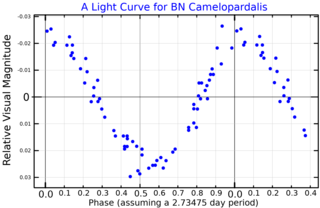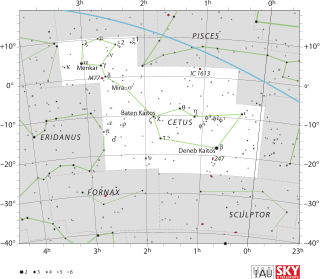
Przybylski's Star, or HD 101065, is a rapidly oscillating Ap star at roughly 356 light-years from the Sun in the southern constellation of Centaurus. It has a unique spectrum showing over-abundances of most rare-earth elements, including some short-lived radioactive isotopes, but under-abundances of more common elements such as iron.
Ap and Bp stars are chemically peculiar stars of spectral types A and B which show overabundances of some metals, such as strontium, chromium, or europium. In addition, larger overabundances are often seen in praseodymium and neodymium. These stars have a much slower rotation than normal for A- and B-type stars, although some exhibit rotation velocities up to about 100 kilometers per second.

V1291 Aquilae is a single star in the equatorial constellation of Aquila. It has a yellow-white hue and is dimly visible to the naked eye with an apparent visual magnitude that fluctuates around 5.65. Based on parallax measurements, it is located at a distance of approximately 278 light years from the Sun. The star it is drifting closer with a radial velocity of −22 km/s.

BN Camelopardalis is a suspected astrometric binary in the northern circumpolar constellation of Camelopardalis. It appears as a variable star that is visible to the naked eye as a dim, white-hued point of light with an apparent visual magnitude that fluctuates around 5.49. The system is located at a distance of around 310 light years from the Sun based on parallax, and is drifting further away with a radial velocity of +9 km/s.
Rapidly oscillating Ap stars (roAp stars) are a subtype of the Ap star class that exhibit short-timescale rapid photometric or radial velocity variations. The known periods range between 5 and 23 minutes. They lie in the δ Scuti instability strip on the main sequence.

Gamma Equulei, Latinized from γ Equulei, is a double star in the northern constellation of Equuleus. It is located at a distance of around 118 light-years from Earth and is visible to the naked eye with a slightly variable apparent visual magnitude of around 4.7. The star is drifting closer to the Sun with a radial velocity of −16.5 km/s.

HD 137509 is a star in the southern constellation of Apus, positioned less than a degree from the northern constellation boundary with Triangulum Australe. It has the variable star designation of NN Apodis, or NN Aps for short, and ranges in brightness from an apparent visual magnitude of 6.86 down to 6.93 with a period of 4.4916 days. The star is located at a distance of approximately 647 light years from the Sun based on parallax, and is drifting further away with a radial velocity of +0.50 km/s.

Xi Phoenicis, Latinized from ξ Phoenicis, is a visual binary star system in the southern constellation of Phoenix. It is faintly visible to the naked eye, having an apparent visual magnitude of 5.70. Based upon an annual parallax shift of 14.61 mas as measured from Earth, it is located around 223 light years from the Sun. The system is moving away from the Sun with a radial velocity of about +10 km/s.

Rho Phoenicis is a variable star in the constellation of Phoenix. From parallax measurements by the Gaia spacecraft, it is located at a distance of 245 light-years from Earth.

HD 74423 is a heartbeat binary star and one component pulsates on only one hemisphere. This is caused by tidal interaction with its partner. The star is located in the Volans constellation.

HR 3831, also known as HD 83368, is a binary star system in the southern constellation of Vela at a distance of 233 light years. This object is barely visible to the naked eye as a dim, blue star with an apparent visual magnitude of 6.232. It is approaching the Earth with a heliocentric radial velocity of 4.0±0.3 km/s.
HR 7355 is a star in the southern constellation of Sagittarius. It is faintly visible to the naked eye with an apparent visual magnitude of 6.03. The star is located at a distance of approximately 760 light years based on parallax measurements. The radial velocity of the star is poorly constrained, but it appears to be receding at the rate of +4 km/s.

HD 125248 is a binary star system in the equatorial constellation of Virgo. It has the variable star designation CS Virginis, while HD 125248 is the designation from the Henry Draper Catalogue. This system is dimly visible to the naked eye as a point of light with an apparent visual magnitude that ranges from 5.84 down to 5.95. It is located at a distance of approximately 280 light years from the Sun based on parallax measurements, but is drifting closer with a heliocentric radial velocity of −8 km/s.

PW Telescopii, also known as HD 183806 or simply PW Tel, is a solitary variable star located in the southern constellation Telescopium. It has an average apparent magnitude of 5.58, making it faintly visible to the naked eye. Based on parallax measurements from the Gaia satellite, the star is estimated to be 395 light years distant. It appears to be approaching the Solar System with a heliocentric radial velocity of −10 km/s. The value is somewhat constrained, having an uncertainty of 26%. At its current distance, PW Tel's brightness is diminished by 0.05 magnitudes due to interstellar dust.

HD 133880, also known as HR 5624 and HR Lupi, is a Bp star about 340 light years from the Earth, in the constellation Lupus. It is a 5th magnitude star, and will be faintly visible to the naked eye of an observer far from city lights. It is an SX Arietis variable star, varying from magnitude 5.76 to 5.81 over a period of 21.0594 hours. HD 133880 is a member of the Upper Centaurus–Lupus association. It is a young star, estimated to have completed only 5±2 percent of its projected main sequence lifetime. It is one of the few stars known to produce coherent pulsed radio radiation via electron cyclotron maser emission.

HR 1170, also known as HD 23728 and V376 Persei, is a star about 220 light years from the Earth, in the constellation Perseus. It is a 5th magnitude star, so it will be faintly visible to the naked eye of an observer far from city lights. It is a variable star, whose brightness varies slightly from magnitude 5.77 to 5.91.

QQ Telescopii, also known as HD 185139 or simply QQ Tel, is a solitary variable star located in the southern constellation Telescopium. It has an apparent magnitude of 6.25, placing it near the limit for naked eye visibility, even under ideal conditions. Gaia DR3 parallax measurements imply a distance of 333 light years and it is currently receding with a heliocentric radial velocity of 7.8 km/s. At its current distance, QQ Telescopii's brightness is diminished by two tenths of a magnitude due to interstellar dust and it has an absolute magnitude of +1.01.

HD 177765 is a white-hued star in the southern constellation of Sagittarius. With an apparent magnitude of 9.15, it is too faint to be seen by the naked eye from Earth, but is dimly visible using binoculars. It is located at a distance of 1,284 light-years according to Gaia EDR3 parallax measurements.

HD 166473 is a rapidly oscillating Ap star and an α2 CVn variable located about 455 light-years away in the southern constellation of Corona Australis. It has the variable star designation V694 Coronae Australis. With an apparent magnitude of 7.953, it is too faint to be seen by the naked eye from Earth, but can be observed using binoculars.

HD 9289 is a white-hued variable star in the constellation of Cetus. It has the variable-star designation BW Ceti. With an apparent magnitude of 9.38, it is too faint to be observed by the naked eye from Earth. It is located at a distance of approximately 1,000 light-years according to Gaia EDR3 parallax measurements, and is moving away from the Solar System at a heliocentric radial velocity of 11.352 km/s.

















